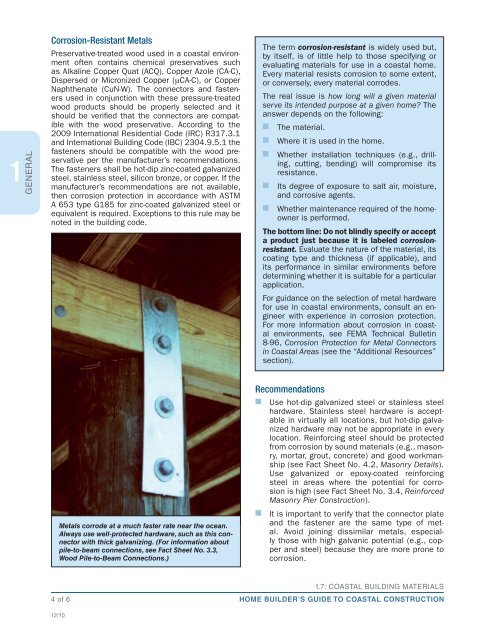FEMA P-499: Home Builder's Guide to Coastal Construction
FEMA P-499: Home Builder's Guide to Coastal Construction
FEMA P-499: Home Builder's Guide to Coastal Construction
Create successful ePaper yourself
Turn your PDF publications into a flip-book with our unique Google optimized e-Paper software.
1<br />
GENERAL<br />
Corrosion-Resistant Metals<br />
Preservative-treated wood used in a coastal environment<br />
often contains chemical preservatives such<br />
as Alkaline Copper Quat (ACQ), Copper Azole (CA-C),<br />
Dispersed or Micronized Copper (mCA-C), or Copper<br />
Naphthenate (CuN-W). The connec<strong>to</strong>rs and fasteners<br />
used in conjunction with these pressure-treated<br />
wood products should be properly selected and it<br />
should be verified that the connec<strong>to</strong>rs are compatible<br />
with the wood preservative. According <strong>to</strong> the<br />
2009 International Residential Code (IRC) R317.3.1<br />
and International Building Code (IBC) 2304.9.5.1 the<br />
fasteners should be compatible with the wood preservative<br />
per the manufacturer’s recommendations.<br />
The fasteners shall be hot-dip zinc-coated galvanized<br />
steel, stainless steel, silicon bronze, or copper. If the<br />
manufacturer’s recommendations are not available,<br />
then corrosion protection in accordance with ASTM<br />
A 653 type G185 for zinc-coated galvanized steel or<br />
equivalent is required. Exceptions <strong>to</strong> this rule may be<br />
noted in the building code.<br />
Metals corrode at a much faster rate near the ocean.<br />
Always use well-protected hardware, such as this connec<strong>to</strong>r<br />
with thick galvanizing. (For information about<br />
pile-<strong>to</strong>-beam connections, see Fact Sheet No. 3.3,<br />
Wood Pile-<strong>to</strong>-Beam Connections.)<br />
4 of 6<br />
12/10<br />
The term corrosion-resistant is widely used but,<br />
by itself, is of little help <strong>to</strong> those specifying or<br />
evaluating materials for use in a coastal home.<br />
Every material resists corrosion <strong>to</strong> some extent,<br />
or conversely, every material corrodes.<br />
The real issue is how long will a given material<br />
serve its intended purpose at a given home? The<br />
answer depends on the following:<br />
n The material.<br />
n Where it is used in the home.<br />
n Whether installation techniques (e.g., drilling,<br />
cutting, bending) will compromise its<br />
resistance.<br />
n Its degree of exposure <strong>to</strong> salt air, moisture,<br />
and corrosive agents.<br />
n Whether maintenance required of the homeowner<br />
is performed.<br />
The bot<strong>to</strong>m line: Do not blindly specify or accept<br />
a product just because it is labeled corrosionresistant.<br />
Evaluate the nature of the material, its<br />
coating type and thickness (if applicable), and<br />
its performance in similar environments before<br />
determining whether it is suitable for a particular<br />
application.<br />
For guidance on the selection of metal hardware<br />
for use in coastal environments, consult an engineer<br />
with experience in corrosion protection.<br />
For more information about corrosion in coastal<br />
environments, see <strong>FEMA</strong> Technical Bulletin<br />
8-96, Corrosion Protection for Metal Connec<strong>to</strong>rs<br />
in <strong>Coastal</strong> Areas (see the “Additional Resources”<br />
section).<br />
Recommendations<br />
n Use hot-dip galvanized steel or stainless steel<br />
hardware. Stainless steel hardware is acceptable<br />
in virtually all locations, but hot-dip galvanized<br />
hardware may not be appropriate in every<br />
location. Reinforcing steel should be protected<br />
from corrosion by sound materials (e.g., masonry,<br />
mortar, grout, concrete) and good workmanship<br />
(see Fact Sheet No. 4.2, Masonry Details).<br />
Use galvanized or epoxy-coated reinforcing<br />
steel in areas where the potential for corrosion<br />
is high (see Fact Sheet No. 3.4, Reinforced<br />
Masonry Pier <strong>Construction</strong>).<br />
n It is important <strong>to</strong> verify that the connec<strong>to</strong>r plate<br />
and the fastener are the same type of metal.<br />
Avoid joining dissimilar metals, especially<br />
those with high galvanic potential (e.g., copper<br />
and steel) because they are more prone <strong>to</strong><br />
corrosion.<br />
1.7: COASTAL BUILDING MATERIALS<br />
HOME BUILDER’S GUIDE TO COASTAL CONSTRUCTION


